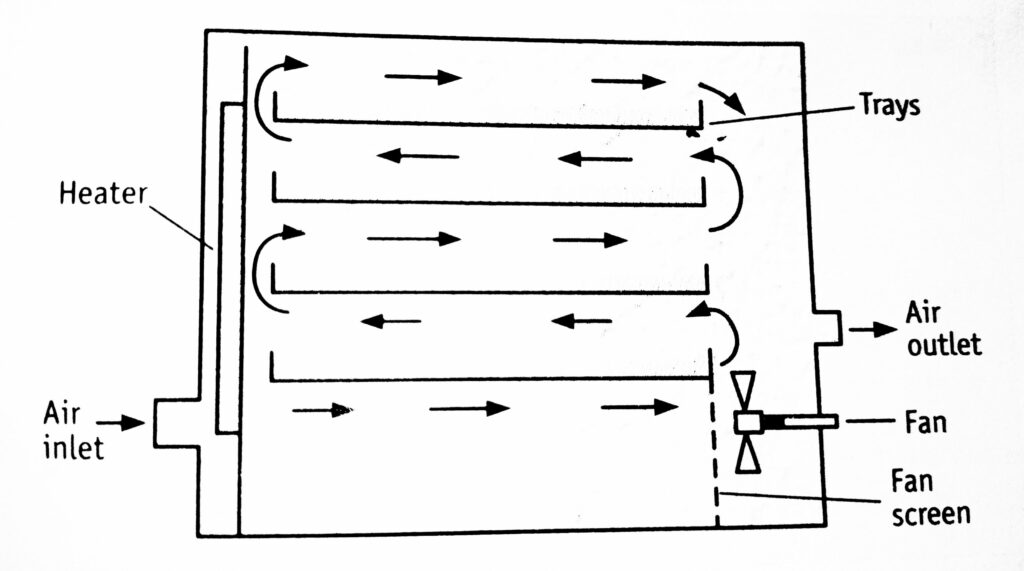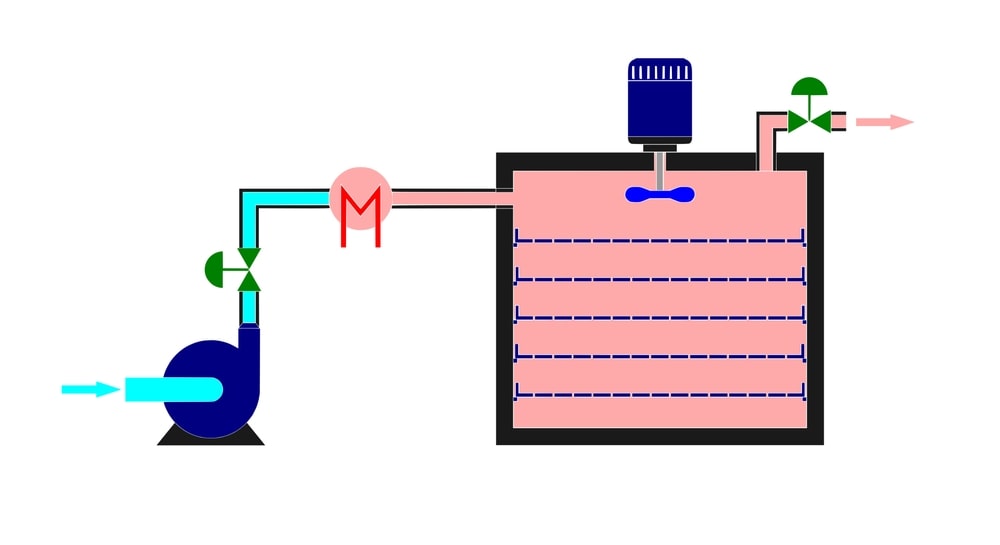Table of Contents
Principle of Tray Dryer
In the tray dryer, hot air is continuously circulated. Forced convection heating takes place to remove moisture from the solids placed in trays. Simultaneously, the moist air is removed partially.
Construction of Tray Dryer
The construction of a tray dryer is shown in Figure 1.1. It consists of a rectangular chamber whose walls are insulated. Trays are placed inside the heating chamber. The number of trays may vary with the size of the dryer. Dryers of laboratory size may contain a minimum of three trays, whereas dryers of industry size may contain more than 20 trays. Each tray is rectangular or square and about 1.2 to 2.4 metres square in area. Trays are usually loaded from 10.0 to 100.0 millimetres deep. The distance between the bottom of the upper tray and the (upper) surface of the substance loaded in the subsequent tray must be 40.0 millimetres.
Alternately the trays can be placed in trucks on wheels, which can be rolled into and out of the chamber. Two such trucks can be arranged inside the dryer. The dryer is fitted with a fan for circulating air over the trays. Electrically heated elements are provided inside (rather than outside) to heat the air (steam also can be used as it is cheaper). In the corner of the chamber, direction vanes are placed to direct air in the expected path.

Working on the Tray Dryer
Wet solid is loaded into trays. Trays are placed in the chamber. Fresh air is introduced through the inlet, which passes through the heaters and gets heated up. The hot air is circulated by means of fans at 2 to 5 metres per second. Turbulent flow lowers the partial vapour in the atmosphere and also reduces the thickness of the air boundary layer. The water is picked up by air. As water evaporates from the surface, the water diffuses from the interior of the solid by capillary action. These events occur in a single pass of air. The time of contact is short and the amount of water picked up in a single pass is small. Therefore the discharged air to the tune of 80 to 90% is circulated back through fans. Only 10 to 20% of fresh air is introduced. Moist air is discharged through the outlet. Thus constant temperature and uniform airflow over the material can be maintained for achieving uniform drying.
In the case of wet granules (as in tablets and capsules) drying is continued until the desired moisture content is obtained. At the end of drying, trays (trucks) are pulled out of the chamber and taken to a tray dumping station. Uses Sticky materials, plastic substances, granular mass or crystalline materials, precipitates and pastes can be dried in a tray dryer. Crude drugs, chemicals, powders, tablet granules or parts of the equipment are dried.
Advantages:
- In a tray dryer, handling of materials (loading and unloading) can be done without loss.
- The tray dryer is operated batch-wise. Batch drying is used extensively in the manufacture of pharmaceuticals for the following reasons.
- Each batch of material can be handled as a separate entity.
- The batch sizes in the pharmaceutical industry are relatively small (250 kg or less per batch) compared with the chemical industry (1000 kg or more per hour).
- The same equipment is readily adjusted for use in drying a wide variety of materials.
- Valuable products can be handled efficiently.
Disadvantages:
- The tray dryer requires more labour to load and unload. Hence, cost increases. The process is time-consuming.
Variants: Tray dryer may be operated under vacuum, often with indirect heating. This is done in special vacuum tray dryers for drying vitamins and other heat-sensitive products.
Tunnel dryer: In this type, trucks are loaded with wet material at once end of the tunnel. The tunnel is comprised of a number of units, each of which is electro-statically controlled. The solids get dried and the product is discharged at the other end of the tunnel.
Make sure you also check our other amazing Article on : Method of Size Separation
